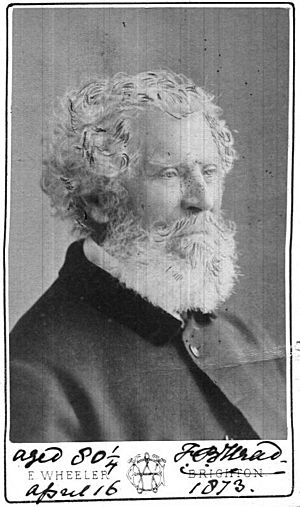Francis Bond Head facts for kids
Quick facts for kids
Francis Bond Head
Bt KCH
|
|
|---|---|
 |
|
| 6th Lieutenant Governor of Upper Canada | |
| In office 1836–1838 |
|
| Monarch | William IV Victoria |
| Preceded by | Sir John Colborne |
| Succeeded by | Sir George Arthur |
| Personal details | |
| Born | 1 January 1793 Higham, Kent |
| Died | 20 July 1875 (aged 82) Croydon, Surrey, England |
| Spouse | Julia Valenza Somerville |
| Profession | Commissioned Lieutenant in the Royal Engineers |
| Signature |  |
Sir Francis Bond Head (born January 1, 1793 – died July 20, 1875) was a key British official. He served as the Lieutenant-Governor of Upper Canada from 1836 to 1838. This was a challenging time, as he was in charge during the rebellion of 1837.
Contents
Who Was Sir Francis Bond Head?
Sir Francis Bond Head was an interesting person with a varied career. He started as a soldier and later became a writer. But he is most remembered for his time leading the colony of Upper Canada.
Early Life and Adventures
Francis Bond Head was born in England in 1793. His family had a unique history, including a Spanish Jewish ancestor who was a doctor to a queen.
He joined the British Army as an officer in the Royal Engineers. This group builds things like bridges and forts for the army. He served from 1811 to 1825 and even earned a medal for his service in the Battle of Waterloo.
After his military career, he tried to start a mining company in Argentina. He became known as "Galloping Head" because he rode horses across the vast plains and mountains of Argentina twice!
In 1816, he married Julia Valenza Somerville. They had four children together.
A Knight and a Commissioner
In 1831, King William IV made him a knight. This happened after Head showed how useful a lasso could be for military purposes.
A few years later, in 1834, Head took on a new role. He became an assistant for the Poor Law Commission in Kent, England. This commission was set up to help poor people.
Head created a plan for a "workhouse" for 500 people. In his plan, men and women were kept separate. However, sick and healthy people, young and old, and even those with mental health issues were all mixed together. He believed that life in the workhouse should not be better than what a working person could earn. This meant small rooms and very plain food, much like the tough conditions described in Charles Dickens' book Oliver Twist.
Governor of Upper Canada
In 1835, the British government appointed Head as Lieutenant-Governor of Upper Canada. They hoped he would calm down the "reformers" in the colony. These reformers, like William Lyon Mackenzie, wanted the colony to have more control over its own government, known as responsible government.
Head tried to work with the reformers at first. He appointed a reformer named Robert Baldwin to his special advisory group, the Executive Council. But Head often ignored Baldwin's advice, so Baldwin resigned.
Political Troubles
The colony's elected assembly, the Legislative Assembly, then refused to approve any money bills. This meant the government couldn't pay for things. Head reacted by dissolving the government and calling for new elections.
During the election campaign, Head strongly supported the "United Empire Loyalists". These were people loyal to Britain. He claimed that the reformers wanted Upper Canada to become like the United States. The "Family Compact", a group of wealthy landowners who supported British rule, won the election.
The 1837 Rebellion
In December 1837, William Lyon Mackenzie led a short rebellion in Toronto. Sir Francis Bond Head later claimed he knew about the rebellion plans. He even boasted that he encouraged it by sending away all the British troops. This, he said, was a trap for Mackenzie. However, there were no troops to send, and local militias were already getting ready.
Head sent the local militia to stop the rebellion. They quickly put it down within four days. Because of the rebellion, Britain decided to replace Head. Sir George Arthur took over as Lieutenant-Governor.
After this, Head returned to England. He spent the rest of his life writing books and essays. In 1867, he became a member of the Privy Council, a group of advisors to the British monarch.
Legacy
Several places in Ontario, Canada, are named after Sir Francis Bond Head:
- Bond Head, a small community northwest of Toronto in Bradford West Gwillimbury.
- Bond Head, a cape on Lake Ontario in Clarington. There is also a nearby settlement and park named Bond Head.
- Three streets in Oakville, Ontario were named Francis, Bond, and Head. Today, only Bond and Head streets remain.
- Two streets in St. Catharines, Ontario, are named 'Bond' and 'Head'. They are short streets that cross each other.
- The community of Frankford, on the Trent River, was named after Head. This happened after he crossed the river there during his travels.
Works
Sir Francis Bond Head wrote several books, often about his travels and experiences:
- Life of Bruce (London, 1830), a book about the Scottish traveler James Bruce.
- Rough Notes Taken during some Rapid Journeys across the Pampas and among the Andes (1826), about his adventures in Argentina.
- Bubbles from the Brunnens of Nassau, by an Old Man (1834), a travel book about Germany.
- The Emigrant (1846), a book about life in the colonies.


